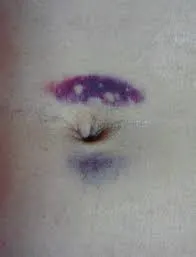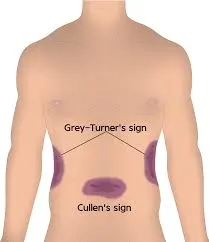Understanding Cullen's Sign: A Blue Belly Button Signal You Shouldn't Ignore
Have you ever heard of Cullen's sign? It's when the area around your belly button turns bluish or purple. While it might seem like just an odd bruise, this discoloration can be an important warning sign that needs medical attention.
What Exactly Is Cullen's Sign?
Cullen's sign appears as a bluish-purple discoloration around your navel (belly button). Think of it like a bruise, but one that appears without you having bumped into anything. Dr. Thomas Cullen first described this sign in 1918, and that's why it carries his name today.
What Does It Look Like?
The appearance typically includes:
- Blue or purple coloring
- Sometimes with a yellowish edge
- Usually around the belly button
- Can spread to nearby areas
- Often tender to touch
- Develops gradually over 24-48 hours

Why Does It Happen?
Imagine your internal organs are like a watercolor painting. When there's bleeding inside your body, the blood follows gravity and tissue planes, eventually showing through your skin - just like how watercolors spread on paper. This happens because:
- Blood from internal bleeding travels through tissue layers
- The blood breaks down
- The breakdown products cause discoloration
- This process takes time, which is why the sign often appears days after the initial problem
Common Causes
| Condition | Description | Urgency Level |
|---|---|---|
| Acute Pancreatitis | Inflammation of the pancreas | High |
| Ectopic Pregnancy | Pregnancy outside the uterus | Emergency |
| Internal Bleeding | Various causes | Emergency |
| Severe Abdominal Injury | Direct trauma | High |
When Should You Worry?
🚨 Important: Cullen's sign is usually a serious signal. If you notice this discoloration, you should:
- Take a photo of the area
- Note when you first noticed it
- Call your doctor immediately or go to emergency care
- Don't wait to "see if it goes away"
Associated Symptoms
| Symptom | Description | Urgency Level |
|---|---|---|
| Abdominal Pain | May be severe or constant | High |
| Nausea/Vomiting | Often persistent | Moderate |
| Light-headedness | Due to blood loss | High |
| Rapid Heartbeat | Above 100 beats/minute | High |
| Fatigue | Unusual tiredness | Moderate |
| Shortness of Breath | Difficulty breathing | High |
Diagnosis Process
| Step | Procedure | Purpose |
|---|---|---|
| Physical Exam | Visual inspection and palpation | Confirm presence and extent |
| Blood Tests | CBC, lipase, pregnancy test | Check for internal bleeding, pancreatic issues |
| Imaging | CT scan, ultrasound, X-rays | Identify underlying cause |
| History Taking | Patient interview | Understand timeline and risk factors |
Comparison with Grey Turner's Sign
Both Cullen's sign and Grey Turner's sign are important indicators of internal bleeding, but they appear in different locations and might suggest slightly different conditions.
| Feature | Cullen's Sign | Grey Turner's Sign |
|---|---|---|
| Location | Around belly button | Flanks (sides of abdomen) |
| Appearance | Blue-purple discoloration | Bruise-like discoloration |
| Time to Appear | 24-48 hours | 24-72 hours |
| Common Causes | Pancreatitis, ectopic pregnancy | Pancreatitis, retroperitoneal bleeding |
| First Described | 1918 by Dr. Cullen | 1920 by Dr. Grey Turner |

Diagnosis with Medical Imaging
Medical imaging plays a crucial role in determining the underlying cause of Cullen's sign. While the sign itself is visible to the naked eye, doctors need to see what's happening inside your body.
Types of Imaging Used:
- X-rays
- Often the first imaging test performed
- Can show free air in the abdomen
- May reveal displacement of organs
- CT Scans
- Provides detailed cross-sectional images
- Can show the extent of bleeding
- Helps identify specific organ involvement
- Ultrasound
- Particularly useful for pregnant patients
- Can detect ectopic pregnancy
- Shows fluid collections in real-time
X-ray Interpreter is an AI-powered tool that can help you understand your X-ray images better. While it's not a replacement for professional medical opinion, it can provide initial insights and help you have more informed discussions with your healthcare provider.
Treatment
Treatment depends entirely on the underlying cause but might include:
- Hospital admission
- Surgery in some cases
- Medication
- Monitoring and support
Prevention
| Prevention Strategy | Description | Importance |
|---|---|---|
| Regular Check-ups | Schedule routine medical visits | High |
| Health Maintenance | Maintain healthy diet and exercise | Moderate |
| Trauma Prevention | Use proper safety equipment | High |
| Family History | Know genetic risk factors | Moderate |
| Early Care | Seek prompt attention for abdominal pain | Critical |
Important Things to Remember
- Cullen's sign is rarely harmless
- It's usually a late sign of something serious
- Don't try to self-diagnose
- Time matters - get help quickly
- Take photos to show your doctor
Frequently Asked Questions
What does Cullen's sign indicate?
Cullen's sign typically indicates internal bleeding in the abdomen or pelvis. It most commonly suggests:
- Acute hemorrhagic pancreatitis
- Ectopic pregnancy
- Severe abdominal trauma
- Internal organ rupture The blue-purple discoloration appears when blood and fluid track through the abdominal tissue to the area around the belly button.
What is Cullen's sign also known as?
Cullen's sign is sometimes referred to as:
- Periumbilical ecchymosis
- Periumbilical bruising
- Cullen bruising These terms all describe the same phenomenon of discoloration around the navel area.
What is the Cullen sign in newborns?
In newborns, Cullen's sign can appear for different reasons than in adults:
- Birth trauma
- Hemorrhagic disease of the newborn
- Rarely, congenital abnormalities However, it's important to note that any unexplained bruising in newborns should be evaluated immediately by a healthcare provider.
What is a positive Cullen sign?
A positive Cullen sign means:
- Visible bluish-purple discoloration is present around the navel
- The discoloration developed without direct trauma to the area
- The appearance suggests internal bleeding The term "positive" simply means the sign is present and observable.
Is Cullen sign an emergency?
Yes, Cullen's sign is considered a medical emergency. Here's why:
- It indicates potentially life-threatening conditions
- The underlying cause usually requires immediate medical attention
- Delayed treatment can lead to serious complications
- The conditions causing it often worsen without intervention
If you observe Cullen's sign, you should:
- Document the appearance with photos
- Note the time you first noticed it
- Seek emergency medical care immediately
- Don't wait to see if it improves on its own
Final Thoughts
Think of Cullen's sign as your body's way of waving a red flag. While it might be scary to see this discoloration, knowing about it could save your life or someone else's. Remember, it's always better to get checked and find nothing serious than to ignore what could be an important warning sign.
💡 Pro Tip: Save a picture of what Cullen's sign looks like on your phone. It's always good to know what to look for, just in case you or someone you know needs this information.
Have you learned something new about Cullen's sign? Share this information with friends and family - it might help someone recognize this important medical sign when it matters most.